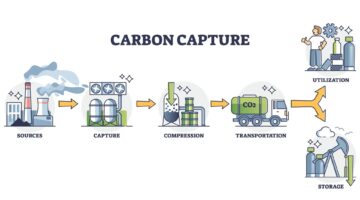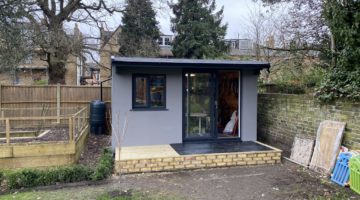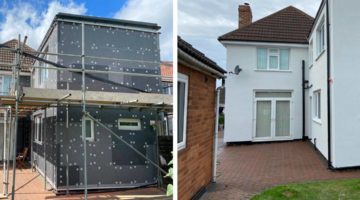
Is retrofitting my uninsulated cavity wall enough?
There are obvious reasons for insulating a solid brick property with external insulation. Houses built before around 1930’s were constructed with a single skin of bricks. While nice to look at and very much of the period, they are terrible at maintaining heat within the property. As there is no cavity to fill, they have to be insulated by installing insulating material onto the external walls – or indeed to the inside.
>>> Learn more about solid wall insulation <<<
This dramatically increases the thermal resistance and helps maintain the property’s warmth throughout winter, while also keeping the home cool during the hot summer months. However, properties built after this period tends to be built using two skins of brick. This leaves a gap in which insulating material can be injected, or added during construction. The question is, does cavity wall insulation do enough, or should you apply external solid wall insulation?
What reasons are there to use external wall insulation on cavity walls.
External solid wall insulation boosts appearance:
When you insulate a property using external solid wall insulation, the system is finished off with a clean rendered finish in a colour of the customer’s choice. A revitalised property can not only brighten up the home but also increase the value of the home. Many properties with exposed brickwork look old and dirty. With a nice rendered finish, these homes are revitalized and help transform them into much sort after properties. Many properties that were built with cavity walls, but not insulated, were also rendered at the same time. This means that if you were to insulate them with cavity wall insulation, you would be left with spots from where the drilling and injecting took place. This damages the appearance of the property and makes it look untidy. A fresh rendered finish over, 100mm of external solid wall insulation, can often be a much better way of insulating.

There has been a lot of press recently surrounding the negatives of retrofitting cavity wall insulation. From radio stations talking about damp, to T.V shows explaining property damage. While we still maintain that a properly credited installer will never have problems and that the number of complaints is a fraction of the industry’s successful installs, we understand that many people aren’t entirely comfortable with the process. External solid wall insulation provides a much more weatherproofed solution, not only halting permeating damp from entering the cavity but also preventing weathering from having a lasting negative effect on the external walls of the property. External wall insulation on cavity walls has further benefits though.
The effects of External solid wall insulation on U-Values
Retrofitting a cavity wall property with injected insulation obviously increases the thermal insulating qualities and lowers the U-Value – heat transfer through the wall. However, to reach the levels of insulation required for the highest level of energy efficiency it might not be enough. Retrofitted cavity walls still leak heat, and with external insulation you may find that you continue to pay large energy bills. One technology that is highly dependent on a well-insulated property is the heat pump. As you may already know, heat pumps are a technology that requires lots of insulation in order to be efficient, and installing them with just retrofitted cavity wall insulation may result in it using huge amounts of electricity in order to reach the required temperature set in the home. Applying external solid wall insulation further reduces the U-Value to below 0.3, meaning the heat pump can work efficiently. In fact, it may only need to be on during the deepest winter months.
Don’t just fill the cavities, externally insulate as well
So don’t just think that because you have cavity wall property, that has be retrofitted with insulation, you can’t insulate it further – you can use external wall insulation on cavity walls. The only extensive insulation method is external wall insulation – it gives you the best U-Value, improves the look of the property and protects the brickwork against weather and penetrating damp.












If you have a house in the SW of England and it gets lashed with rain ,DO NOT GET CAVITY WALL INSULATION. My house is ruined . Its a 1950’s ex council house in Plymouth , I have been fighting to get my house fixed back the way it was for over a year now and still CIGA are trying to wriggle out of it
I too have had to have cavity wall insulation removed, by knocking bricks out, requiring replastering, at great expense. It turns out that 80% of cavity wall properties are not suitable for cavity wall insulation because of the prevailing weather in our country. Will externally cladding my home mean I won’t have to remove further cavity wall insulation? That is the next question.
Also with the added benefit of having ewi is saving a Huge amount of £££’s on your energy bills
Hi Ben, by our calculations you save about 50% of your gas heating bill. Also VAT is only 5% at the minute (may change in the nearish future) so well worth doing.